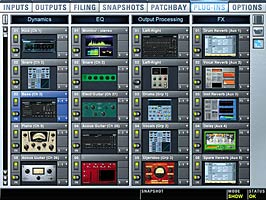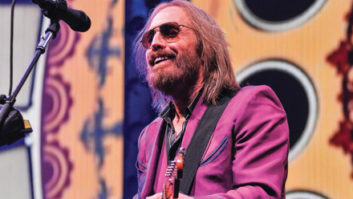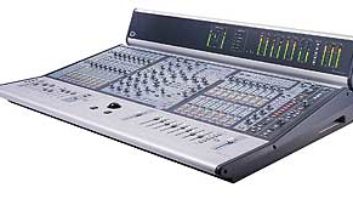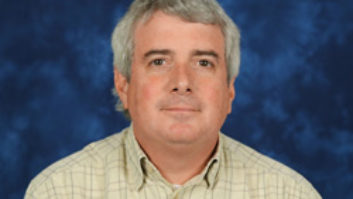

Since its arrival some 18 months ago, Digidesign’s VENUE has found acceptance on major tours with more than 300 systems in use worldwide. This modular system comprises the D-Show console surface, the FOH Rack (housing the system’s mix engine), the Stage Rack recallable, remote-controlled preamps, and a multichannel digital snake. Here are a few tips I’ve learned and discovered in using VENUE during the past year while mixing front of house for Nine Inch Nails and AFI (November 2006 “Tour Profile”).
The Plug-Ins tab in the D-Show software can organize up to 100 plug-ins in four user-definable “racks” for fast access.
KEEP A CLEAN HOUSE
If there are plug-ins installed that you know you definitely won’t need, disable (but don’t remove) them from the Options/Plug-ins list. The console will boot more quickly. You can always enable any of them again without re-installing their software.
AVOID CLIPPING
As an old-school engineer, I like to keep my input faders around the unity (0) mark while mixing. I also like to run my input-channel gain as hot as possible, especially if I’m multitracking to Pro Tools via HDx. In the digital world, if you’re running a full band’s worth of inputs, this scenario will inevitably cause the console’s outputs to clip pre-fader (in the “summing amp” stage), and no matter where you have the master fader, you’ll see a lot of red on the meter. To combat this, I keep one VCA with every input fader (except any effects returns) assigned to it — a “master trim,” if you will. This way, I can keep my input faders where I like them, and if things are getting too hot at the output stage, then I just back off the master VCA by 3 to 4 dB and raise the output fader by the same amount. Don’t forget to make up the gain you’ve lost to your effects sends, and so on.
CHANNELS, NOT RETURNS
I always try to set up the console with more input faders than I have inputs from the stage (unless you have a 96-input stage). In other words, if you have a full 48-input Stage Rack, then select 64 inputs in the Options/Config page. That way, you can have effects returns and external sources coming in on regular input channels with full EQ and dynamics, etc., instead of the more limited options on the stereo effects returns.
OSCILLATOR ROUTING
I normally use the onboard oscillator to line up system processing and to “noise out” the main P.A., but when it came time to put pink noise on a channel, I realized I would need to insert the signal-generator plug-in. I didn’t understand why I could hear it, despite the fact that it wasn’t showing up on the input meter. Eventually, I found the solution: Don’t “insert” it. Assign the plug-in’s output and its “input” (although technically speaking, this plug-in has no input) to the top of the channel. This way, the channel sees this as an input.
THOSE EXTRA PREAMPS
There are two mic preamps on the control surface/FOH Rack. One is the talkback, located on upper-right-hand corner of the main control surface. The other, called “Comm,” is on the back of the FOH Rack on the left side of the I/O card. I thought it was for Clear-Com, but it’s actually a mic pre and less noisy than the talkback, and is also assignable to the monitor/headphone section as a proprietary talk-over.
For example, if your monitor engineer or stage manager needs to reach you quickly, plug them into this input (use a mic with an on/off switch), and they can automatically speak to you on top of whatever you may have going on in your monitors/’phones. Or, if you’re like me and you EQ the P.A. with a Shure SM58 and your own voice, your dulcet tones will never have sounded better. The only slight hitch is that the gain control for this mic pre is right next to the XLR input on the rear, but what’s a few more minutes on your knees, anyway? Both mic preamps can be found and soft-patched in the FOH tab of the patchbay inputs folder.
IPOD WALK MUSIC
I use an iPod for playback of walk-in and walk-out music, and now also for storing backups of my D-Show files and plug-in software. The iPod acts just like a USB drive. You need to put the plug-in software in a folder named “TDM Plug-Ins” or the plug-ins won’t be recognized. The USB port on the FOH Rack is faster than the one on the console, by the way. Hey, you can charge your iPod, too!
EXTRAS, EXTRAS
The D-Show System Support page on Digidesign’s Website is a great resource, with software updates, compatibility information, FAQs and useful technical documentation. One recommended application is D-Show stand-alone software, which is available only for Windows XP.
If you have a laptop, you can pre-configure performances, assign hardware I/O and D-Show routing, name channels, create a library of D-Show setups, store and recall setups, set channel input/EQ/dynamics/pan and more — from the tour bus, airport or hotel. It also offers a way to learn the basics of the D-Show software interface in preparation for working at a full D-Show system. Best of all, it’s a free download at www.digidesign.com.
Pete Keppler is a recording engineer who also enjoys mixing live sound with acts such as David Bowie, Nine Inch Nails and AFI.

THE ERGONOMIC STEREO INPUT
If you know you’ll be making some stereo input channels, then when making
your input patch, assign the left input to the fader channel you want and
then assign the right input to one of your extra channels at the very
end of the patchbay. For example, if you want your stereo keyboard input to be on channel 16, then assign the left input to 16 and the right input to channel 64. Then make your stereo fader by combining these two inputs. After you enter
the “make stereo” mode, be sure you pick the lower-number channel
first. That way, if you need to split the stereo channel again, you
won’t inadvertently re-arrange your fader layout. You can always drag
and drop your other input fader if you need to.
Read about Keppler’s usage of VENUE for the recent AFI tour: Click here
Tips From Other VENUE Power Users
Doug Nightwine, FOH for Joe Satriani:
The guys that are out there mixing on digital consoles now like the [Yamaha] PM1D, PM5D or the DiGiCo are going to take to VENUE because they’re used to the concept of selecting a channel and working on a master channel where you do everything on one set of knobs. And you can have the great-sounding plug-ins you want all onboard. For the guys that aren’t familiar with Pro Tools, it shouldn’t really be that big of a deal. It’s not a redesign of Pro Tools. It does share some of the same technology, like the HD Accel cards are the basis for the mix engine and the plug-in architecture, but that’s where the similarities end. VENUE is purpose-built from the ground up for live mixing. There’s a lot of uncluttered, visual feedback on the console. And it’s not a prerequisite to have experience with Pro Tools. If you do, then you’ve certainly had experience with the plug-ins and how you manage DSP, but it’s certainly not something you have to be familiar with before.

Brad Madix, FOH for Shakira
I’m a big fan of mixing in the digital environment. Being able to call up any input or output and have it placed directly in front of me on the work surface allows me to manipulate small facets of the mix while staying focused on the overall mix. It also lets me make small changes while keeping up with the hundreds of cues we have written into the [Shakira] show. As for the VENUE, it’s great to have access to the same plug-ins that were used to mix the record. During a show, there are numerous changes to individual inputs [EQ, fader rides, mutes], but I spend most of my time with the VCAs in front of me. When a musician switches from one instrument to another, that ride is made on the input, which may or may not be on the top layer. I can still control the level with the VCA and I don’t have to move an inch. If an update to the EQ is necessary, I can call that input up with a click of the mouse and make the changes while keeping my hand on whatever VCA I might need to be riding at that point.

Richard “Basil” Ferneley, FOH for Massive Attack
This is my first time on the Digidesign console. The plug-ins are all very good, which means that we don’t need to carry any outboard gear. The only rack gear I have is a CD player for walk-in music! We are also carrying another CD for recording and a Pro Tools rig to multitrack record every show.
Chris Rabold, FOH for Widespread Panic, on using VENUE’s Virtual Soundcheck
Often times, I’ll listen back during the day to the previous night’s show through a pair of near-field monitors. I’ll work on this or critique that. The ability to work on the mix without the band even in the building is a dream. It hones your skills and challenges you to go back and look closely at what you’re doing as an engineer. It’s a pretty big statement, but I truly feel that VENUE has helped make me a better engineer.



